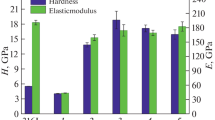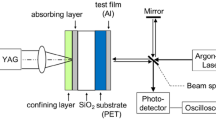Abstract
The adherence of a glass bonded Pt-Au thick film conductor to various alumina substrates is degraded by changes in the surface composition of and by the presence of (0001) crystallographic texture in the substrate. Using the critical fracture energy (γIC) required to separate the thick film from the substrate, it was found that γIC was reduced from a maximum of 3.7 J m−2 using an as-received 96+ wt% alumina substrate to ∼2J m−2 using an as-received 99+ wt% alumina. In addition, the thick film adherence γIC using (0001) sapphire substrates was less than that using (11¯23) sapphire. The 96 wt% substate exhibited essentially a random crystallographic surface texture and a considerable amount of surface silicates. The as-received 99+ wt% Al2O3 substrate was charactarized by a high (0001) surface texture and, while exhibiting a similar composition silicate layer as that of the as-received 96 wt% alumina, the total amount of the glass layer is greatly diminished. Fractographic analysis of the separated thick films and substrates showed that changes in the substrate crystallographic texture and the glass layer diminish the interpenetrating nature of the glass—metal interface and weaken the glass—substrate interface. Such changes in thick film microstructure lead to poorer thick film adherence.
Similar content being viewed by others
References
P. F. Becher andW. L. Newell,J. Mater. Sci. 12 (1977) 90.
P. F. Becher, W. D. Bascom, J. L. Bitner andJ. S. Murday, Proceedings of the International Microelectronics Symposium International Society for Hybrid Microelectronics, Montgomery, Alabama (1975) pp. 279–286.
C. J. Peckinpaugh andR. Tuggle, Proceedings of the International Microelectronics Symposium International Society for Microelectronics (Park Ridge, III. 1968) pp. 417–421.
S. S. Cole andF. J. Hynes,Bull Amer. Ceram. Soc. 37 (1958) 135.
J. R. Floyd,ibid 42 (1963) 65.
T. T. Hitch, E. J. Conlon andW. I. Rogers, in [2] pp. 287–295.
S. W. Freiman, D. R. Mulville andP. W. Mast,J. Mater. Sci. 8 (1973) 1527.
Y. Nakada andT. L. Schock,J. Amer. Ceram. Soc. 58 (1975) 409.
F. V. Dimarcello, P. L. Key andJ. C. Williams,J. Amer. Ceram. Soc. 55 (1972) 509.
P. F. Becher, W. L. Newell andR. W. Rice, Progress Report, NAVAIR, AIRTASK A310310B/ 4R2103-001, NRL, Washington, D.C., January 1975.
D. R. Biswas andR. M. Fulrath,J. Amer. Ceram. Soc. 58 (1975) 526.
N. Claussen ibid 59 (1976) 49.
S. W. Freiman andL. L. Hence,ibid 55 (1972) 86.
R. C. Sundahl,J. Vac. Sci. Technol. 9 (1971) 181.
Author information
Authors and Affiliations
Rights and permissions
About this article
Cite this article
Becher, P.F., Murday, J.S. Thick film adherence fracture energy: influence of alumina substrates. J Mater Sci 12, 1088–1094 (1977). https://doi.org/10.1007/BF02426844
Issue Date:
DOI: https://doi.org/10.1007/BF02426844




